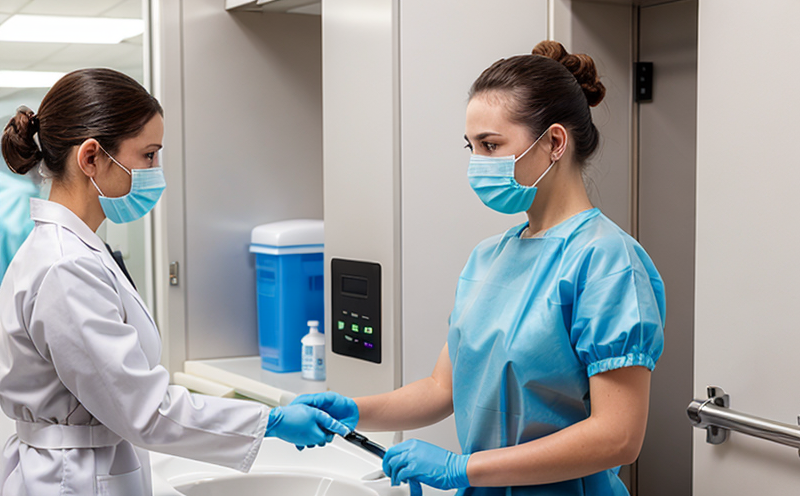GB T 24346 Determination of antifungal resistance in fabrics
The GB T 24346 standard is a crucial method for determining the antifungal resistance in fabrics. This test ensures that textiles maintain their hygienic properties and can effectively resist fungal growth, which is vital for products intended to be used in various environments such as hospitals, schools, and homes.
The process involves exposing fabric samples to different types of fungi under controlled conditions over a specified period. The effectiveness of the fabrics is then measured by assessing the reduction in fungal colony count on the sample surfaces. This standard ensures that textiles meet stringent hygiene requirements and helps manufacturers comply with regulatory standards.
GB T 24346 is widely used in industries where fabric hygiene is critical, such as healthcare, sports, and leisure. The test not only evaluates the antifungal properties of fabrics but also provides a clear understanding of their performance under real-world conditions. This information helps quality managers make informed decisions about product development and procurement.
For R&D engineers, this standard offers insights into the potential improvements in fabric technology for enhanced hygienic qualities. Compliance officers can use it to ensure that products meet national and international standards, thereby avoiding potential legal issues. By understanding the methodology and requirements of GB T 24346, procurement teams can select suppliers who adhere to high hygiene standards.
The test procedure typically involves:
- Preparation of fabric samples according to specified dimensions and conditions.
- Incubation of samples with fungi in controlled laboratory environments.
- Evaluation of fungal growth on the sample surfaces before and after treatment.
- Determination of antifungal resistance through quantitative analysis.
The standard specifies detailed procedures for each step, ensuring consistency across laboratories. This helps in generating reliable and comparable results that can be used to make informed decisions about product quality and compliance.
| Standard Code | Title of Standard | Description |
|---|---|---|
| GB T 24346-2009 | Determination of antifungal resistance in fabrics | Describes the method for determining the antifungal resistance of fabrics. |
| ISO 17690:2015 | Sterilization — Sterility test on medical devices by means of chemical sterilants and other chemicals | A related international standard that provides additional context for understanding the importance of antimicrobial resistance testing. |
The use of GB T 24346 ensures that fabrics meet stringent hygiene standards, which is essential in environments where microbial contamination can lead to health issues. By adhering to this standard, manufacturers and suppliers can ensure the quality and safety of their products.
Why It Matters
The importance of GB T 24346 cannot be overstated in ensuring the hygiene of textiles used across various sectors. In healthcare settings, for instance, fabrics that fail to resist fungal growth can harbor harmful microorganisms, leading to infections and other health risks. The test results provide a clear indication of how effectively fabrics can prevent the spread of fungi.
In sports and leisure industries, where fabric hygiene is equally critical due to frequent use and potential exposure to moisture, the ability to withstand fungal growth is paramount. Consumers expect products from these sectors to be durable and hygienic over extended periods. GB T 24346 helps meet these expectations by providing a robust method for assessing antifungal properties.
For quality managers, compliance officers, R&D engineers, and procurement teams, the standard offers valuable insights into fabric performance that can influence product development, regulatory compliance, and supplier selection. By ensuring adherence to this standard, organizations demonstrate their commitment to maintaining high hygiene standards in all products they produce or distribute.
Applied Standards
The application of GB T 24346 is broad but focuses primarily on the textile industry where fabric hygiene is critical. The standard ensures that fabrics can effectively resist fungal growth, which is essential for maintaining product quality and consumer safety.
| Standard Code | Title of Standard | Description |
|---|---|---|
| GB T 24346-2009 | Determination of antifungal resistance in fabrics | This standard specifies the method for determining the antifungal resistance of fabrics, ensuring they meet stringent hygiene requirements. |
| ISO 17690:2015 | Sterilization — Sterility test on medical devices by means of chemical sterilants and other chemicals | A related international standard that complements GB T 24346 by providing additional context for understanding the importance of antimicrobial resistance testing. |
The use of these standards ensures consistency in testing procedures, leading to reliable results that can be used to make informed decisions about product quality and compliance. By adhering to GB T 24346, manufacturers and suppliers can ensure the hygiene and safety of their products.
Environmental and Sustainability Contributions
- Promotes the use of sustainable materials in fabric production by ensuring that these materials meet stringent hygiene standards.
- Fosters innovation in textile technology, encouraging the development of fabrics with enhanced antifungal properties.
- Reduces waste by identifying and addressing issues early in the product lifecycle, ensuring products are durable and hygienic over extended periods.
- Contributes to the overall improvement of public health by preventing the spread of fungal infections through effective fabric hygiene.
The application of GB T 24346 not only enhances fabric performance but also supports environmental sustainability by promoting the use of sustainable materials and innovative technologies. This standard plays a vital role in ensuring that textiles contribute positively to public health and the environment.





